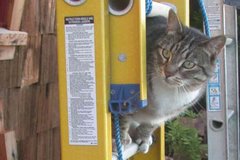The CASEIS16 cruise continues to be successful
The official CASEIS Cruise Blog is located here: http://www.ipgp.fr/caseis This official blog is written by my shift-mate Lola Johannes.
We have challenges and overcome them...
June 10, 2016
Here Dr. Beck discusses the sedimentary structures in this core to Dr. Feuillet, Gaelle, and Lola.
This shows a ball and pillow structure that Dr. Beck was discussing in the above photo. The top of the core is to the left. The sediment on the left is a sand at the base of a turbidite. The brown sediment below this sand is hemipelagic sediment (background sedimentation between turbidites and tephras). Below the hemipelagite is another turbidite. As the overlying turbidite was deposited, it caused a heavy load in the underlying sediment, causing some of the sediment to push up and some to push down. This is the cause of this ball and pillow structure (the wavy contact between the sand and the hemipelagite between 38 and 44 cm).
We are making good time on our cruise, as the N/O Pourquoi Pas cuts through the sea.
June 11, 2016
I presented my research offshore of Sumatra today. This talk was well attended by both science crew and the ship’s crew. The main purpose was to help the science crew learn about turbidite Paleoseismology. I discussed one of the key tools used to discriminate from various different landslide triggering mechanisms.
The core cutting saw malfunctioned today. We are equipped to repair our instruments as there is not a hardware store around the street corner or in the local neighborhood. Tony, part of the coring engineer crew, repairs the core cutting saw.
Here Dr. Beck and Lola describe the stratigraphy found in core CAS16-16PC.
This is a plot of the wire tension. The vertical axis is tension in tons (1-14 tons). Time is from left to right. As the core is being lowered, the tension fluctuates between 4 and 5 tons due to ship heave (ocean swell) and the elastic nature of the cable. When the core drops into the sediment, the tension rapidly drops to about 1 ton (the weight of the cable, etc.). Then the winch is operated to pull the core out of the mud. This is represented by an increase in tension, up to about 12 tons. At this point, the tension drops to the ambient weight of the sediment core, the weight stand, and the cable. Note how the weight is slightly more than it was before the core went into the sediment. This difference is the weight of the sediment in the core.
Here Chloe give us a thumbs up because we see that there is sediment covering the outside of the core pipe (telling us that the core was embedded in sediment.
Dr. Beck looks at the sediment to see what type of sediment that the core sampled. We found that there were foraminifera in this sediment, so this core will be useful for radiocarbon age control.
June 12, 2016
Here the ship’s crew prepares another piston core. Note that they are wearing all the appropriate safety gear (steel toe boots, helmets, and life vests). The large rectangular shaped device on the top of the core is the weight stand. The red, white, and orange rectangular shaped objects are weights. We can change the amount of weight in the weight stand depending upon how deep we want to core. The deeper that we want to core, the more weights we use.


No comments:
Post a Comment